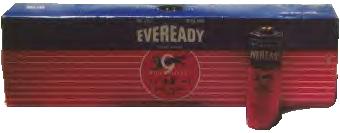

(This is a picture of a set of actual TransOceanic batteries. They're not mine; I got the photo off of a web site.)
The Zenith TransOceanic series of radios were meant to be portable from the beginning. Zenith, and later Eveready, offered a special battery pack for many years. Unlike most portable tube radios, which used separate "A" (1.5 to 9 volts, depending on the radio) and "B" (22.5 to 90 volts, depending on the radio) batteries, the TransOceanics used a special combination A/B battery which put out both 9 and 90 volts. While most "A" batteries are very common (usually C or D cells were used) and "B" batteries are still available (Eveready still makes 22.5, 45 and 67.5 volt batteries, although they are somewhat expensive), the TransOceanic battery packs (Zenith# 985/985X and Eveready# 752) have been discontinued for many years. Unlike standard B batteries, which used 9-volt battery style snap connectors, TransOceanic batteries use a strange style of 4-pin plug which is very hard to come by.
Luckily, old TransOceanic batteries, while scarce and long-dead, can be used to make new battery packs if the guts are taken out and replaced with modern batteries. Another type of battery used by the TransOceanic, the F-cell, was used by 600-series TransOceanics to power the dial light. These were D-cells with a two-prong connector on the top, and are also long-discontinued. Dead TransOceanic battery packs have been commanding high prices on eBay ($45 for a set of A/B and F batteries). Those of us who can't locate an old TransOceanic battery pack could build one from scratch. A suitable plug could possibly be found from refurbishers of old car radios, as 1950's car radios use the same style of plug as a TransOceanic battery pack.
Though it worked fine on AC, I decided to build a battery pack to power my Zenith TransOceanic model B-600. Since I didn't have an old TransOceanic battery pack, I decided to build one from scratch. Someone sent me a suitable four-pin plug, as well as the pinout for the battery connector. The battery pack I built uses ten 9-volt batteries in series for the 90-volt supply, and unlike the makeshift battery pack on Warren's page, which uses two 9-volt batteries in parallel for the 9-volt supply, mine uses six D batteries in series for the 9-volt supply. Why? six D batteries in series will last much longer than two 9-volt batteries in parallel, since the D batteries have a larger milliamp-hour (mAh) rating (six D batteries in series have a mAh rating of 16800, as opposed to the 400 mAh rating of the two 9-volt batteries in parallel). Since the current drain in the 9-volt supply is larger than that of the 90-volt supply, it is not economical to use 9-volt batteries for the 9-volt section, unlike D batteries, which will last much longer. The opposite holds true for the 90-volt supply (if someone were to use D batteries for the 90-volt supply, they would have to use 60 of them connected together in series, which wouldn't fit in the battery bay; 60 AA batteries in series, however, would be a bit more manageable).
I bought ten 9-volt battery connectors to use for the 90-volt supply, two D-cell holders (one holds four D-cells in series, while the other holds 2 D-cells in series; these holders are connected together in series). As for the dial light battery, I originally used a Radio Shack single D-cell holder which connected to the prongs of the dial light connector with wires wrapped around them, as I didn't have a suitable plug. This proved to be a pain, since the connection was very intermittent. Then I emailed Jim Poitivient, who makes battery packs for Zenith Trans-Oceanics (his version, which costs $89.95, uses nine D batteries along with an inverter to make both the 9 and 90V sections, as well as a tenth D-cell for the dial light; If interested, email him. The reasons I didn't buy a pack from him was that I can't afford one, and I'm a DIYer at heart), and he sent me a D-cell holder along with a suitable connector. I replaced the Radio Shack holder with the one he sent me, and it works much better.
The 9-volt batteries are taped together with electrical tape, and the D-cell battery holders for the 9-volt supply are also held together by electrical tape. The dial light battery is held to the board using the double-sided tape Jim included on the bottom. All the batteries are held to a piece of cardboard with duct tape (temporarily until I can find a suitable enclosure). At first, I was wary of trying the battery, knowing that a miswire would send 90 volts to the filaments, frying them instantly. After testing the voltages thoroughly, I decided to try the battery pack. To my surprise, it works perfectly! I started picking up BBC, as well as other shortwave stations, immediately. The dial light also works. Finally my TransOceanic is a truly portable radio. I've since acquired an original battery box and connector, which I intend on someday turning into a more authentic looking battery pack.
A diagram
of the layout of my battery pack can be found here.
Pictures of the battery pack I built coming later.
More on TransOceanic battery packs
Warren's TransOceanic battery page (archive)
Phil Nelson's TransOceanic battery page
Zenith TransOceanic Battery Project
Reproduction TransOceanic battery boxes and connectors
Site Navigation:
Back to the Trans-Oceanic page!
Back to my old radio page!
Back to the main page!